Elac Adante AF61 AF-61 Stereophile 2019 Class A Restricted Extreme LF
Listed · 3604 Views
15 Watchers
Items from this seller
This listing has ended.
Listings Similar to Elac
Time Left: None
This listing has ended.
| Condition | |
| Payment methods | |
Contact seller after sale to pay viaExpress Checkout, VISA/Mastercard, American Express, Discover, Certified check, Personal check or Wire Transfer | |
| Ships from | Albuquerque, NM, 87110 |
| Ships to | United States |
| Package dimensions | 23.0" × 16.0" × 26.0" (43.5 lbs.) 23.0" × 16.0" × 26.0" (43.5 lbs.) |
| Shipping carrier | FedEx |
| Shipping cost | Free |
| Original accessories | Box, Manual |
| Research Pricing |
**AS-61 UPDATE** ONE pair gloss white sealed, ONE pair red veneer mint demos
**AC-61 UPDATE** ONE gloss white sealed center channel
**AS-61 Stands UPDATE** ONE pair sealed, ONE pair demos
**AC-61 Stands UPDATE** ONE sealed center stand left **AF-61 UPDATE** SOLD OUT
The AS-61 is the top half of the floorstanding model that Stereophile magazine just rated for 2019 Class A (Restricted Extreme LF). At this price, these speakers are selling quickly locally as well, so inquire with your desired finish soon. Price will include shipping to anywhere in the continental US. Inquire about AS-61 in (gloss white, and red veneer) stand mount speakers, AC-61 center channel (gloss white), sorry other colors center sold out. All products come with full Elac warranty, Herndon Audio is an authorized Elac dealer. Also limited quantities available of the heavy-duty, ELAC, black, metal, sand/lead fillable stands for the both the AS-61 and AC-61. Herndon Audio ships the same day payment is received, shop with confidence and look at our hundreds of positive feedback transactions over the past 13+ years. Herndon Audio can take all credit cards, PayPal, AudioGon Express Checkout (Stripe), check, etc. Price includes shipping, insurance, and transaction fees, everything to your door.
<review from Feb 2019 The Absolute Sound magazine of the similar floor standing AF-61>
The Elac Adante series of loudspeakers, especially the compact AS-61, have been the darlings of the press since the first one reached a reviewer’s listening room. Recently the AS-61 received the coveted 2018 EISA award. While the bookshelf-sized Adante has been a veritable rock star, the larger floorstanding model, the AF-61VR (A is for Adante, F is for floor, VR is rosewood veneer), has seen far less journalistic sunlight. That just isn’t right…so I will attempt to rectify the situation.
The Elac Adante AF-61VRs are priced at $5000 a pair. To be perhaps overly candid, I assumed the AF-61s were $5k each for most of the time I had them in my clutches. While this misunderstanding was partially a result of how rapidly “mid-priced” floorstanders have gone up in price during the past five years, it was also due to the AF-61s’ high level of build- and sound-quality. Let me put it this way: For $10k/pair I thought the AF-61s were an excellent, highly competitive option. For $5k a pair they are an obscenely good value. But are the Adante AS-61 floorstanding loudspeakers “the ones” for you? Hopefully, this review will help clarify that.
Technical Details
To the casual eye there doesn’t seem to be much that’s special about the AF-61. It looks, from the outside, like just another nicely finished multiple-driver box speaker with a rosewood veneer. Upon second glance you’ll notice that it’s not rectangular—its sides are slightly angled so they meet at a center-point, and there’s a second driver surrounding the 1" soft-dome tweeter, so it’s actually a concentric-driver design.
The Adante AF-61 is an example of “stealth” technology taken to extreme measures. The three 8" aluminum-cone woofers that reside below the concentrically-mounted 1" soft dome and 5.25" aluminum-cone midrange are passive radiators! Located behind each lightweight 8" passive cone is an active 6.5" aluminum-cone driver. Elac calls this configuration a “3-way interport-coupled-cavity design.” The internal ports work in conjunction with the passive drivers to further control and smooth the AF-61’s output. Because of the internally vented box, the front section (the area behind the passive driver and in front of the active one) serves as a second-order low-pass filter.
To integrate the AF-61’s five active and three passive drivers the crossover required was, in Andrew Jones’ words, “complicated.” It wasn’t “complicated” because it required a lot of parts, but because the AF-61’s crossover combines multiple physical and electrical elements in a way that they have an effect on each other. Many iterations and variations were required to find the ideal combination. Without computer-assisted design tools it would have taken far too long to parse the various possibilities. In a video interview Andrew Jones said, “With a regular crossover network, if you need to change its characteristics you pull or change an inductor and a capacitor. Here, to change the crossover you must change a physical volume or a mass. Unless you have a very accurate electric/acoustic model you end up cutting wood all the time.”
According to the published specifications, the crossover points in this three-way design are at 200Hz and 2kHz. I’m positive these are not your garden-variety, loudspeaker-cookbook, simple first- or second-order filters.
With a published sensitivity of 87dB at 2.83V/1m and a nominal impedance of 6 ohms, on paper the AF-61 doesn’t appear to be a difficult load for an amplifier to drive. During my review I used the Digital Amplifier Co’s Cherry Megaschino (800 watts into 4 ohms) as well as the less powerful Pass X150.5 (150 watts). Neither exhibited any signs of difficulty or strain while powering the AF-61 loudspeakers.
The published specification for the AF-61 lists its frequency response as 39Hz to 35kHz, which is only slightly more extended on the low end than its smaller stand-mounted sibling, the AS-61, which is rated as extending to 41Hz. The AF-61 does have 2dB greater sensitivity than the AS-61. With a double set of five-way binding posts, you can bi-wire or even bi-amp the AF-61s if you wish.
The AF-61s are available in gloss white, rosewood veneer, and gloss black. My review samples were the rosewood veneer version. The rosewood looked exquisite, and the black metal grille (I only received one) gave the AF-61 a clean, elegant, modern appearance. Obviously, I did all my listening sans grilles.
Setup
The review pair of Elac Adante AF-61VR loudspeakers arrived on a pallet that weighed-in at slightly over 250 pounds. My current home has ten concrete steps between the sidewalk and my front door. My first thought upon seeing the delivery in progress was, “Oh boy….” That last phrase contained equal amounts of anticipation and dread. While I had been looking forward to hosting the AF-61s for several months, the reality of adding two more 101-pound boxes to my abode was, in itself, daunting. The countervailing emotion was the expectation that the final sonic results would sound as wonderful as they had during audio-show demos.
Because of their size and weight, I did not install the AF-61s in my downstairs system. Instead the two loudspeakers spent their time at Casa Stone in the main-floor open-concept living room. And while the ten-foot-high ceilings and installed sound treatments make the room more loudspeaker-friendly than most multipurpose rooms, it is not a dedicated listening space. Instead it is a real-world room with other people, plants, and cats. While this may not have afforded me the level of environmental control I have in my dedicated listening room, it did let me see how well the AF-61s could perform in a real-world multi-use space
The previous inhabitants of this room, a pair of Skiing Ninja-modified AV123 X-Statiks had been augmented by a pair of small subwoofers. With the AF-61s, in this room I found that on most musical material the subwoofers were unnecessary. I crossed the subs over at 40Hz, so except during cinematic explosions and synth-bass rumbles they were not really being used, and even when active they didn’t add much to the AF-61’s presentation. The AF-61s are capable of producing a lot of bass, which is great as long as your room can support it. My main-floor room apparently can.
Because the AF-61s are point sources with the midrange surrounding the tweeter, setup, specifically accurate triangulation, is critical to obtaining optimum imaging and soundstaging. But unlike some point-source designs that limit your lateral movement, once these speakers were set up, the listening sweet-spot was large enough that no amount of physical movement or head-bobbing could propel me out of the listening happy place.
This is as good a place as any to ’fess up to the fact that I did not employ the AF-61’s outrigger base and spikes. My main reason for leaving them off was that the outriggers made placement more difficult within the area where the loudspeakers needed to reside. And while the AF-61s would be more stable with the outriggers employed, I don’t own a large dog or have small children. Even without the outrigger the AF-61s were extremely stable on the nice, level, laminate flooring in my three-year-old home. Also, after several days of listening I concluded that my lower-than-average-height couch, combined with a mid-field listening distance of 7.5 feet from ears to concentric drivers, meant that the tweeter was closer to parallel with ear height without employing the outriggers. With them installed the tweeter would have been high enough so that if a listener slouched, he could begin to notice some upper-frequency differences.
Sonic Performance
Usually my listening sessions are solo affairs in my downstairs listening room, but since the Elac AF-61s were ensconced in the living room, my wife had ample opportunity to kibbutz. She was the first person to notice the Elac’s ability to fill a space with sound. Even in my wife’s office, which is slightly more than fifteen feet away from the back of the AF-61s, the sound was surprisingly full-range and not lacking in detail. My wife was the first member of my household to conduct a LIAR (listening in another room) test of the AF-61s, and they passed with flying colors. In fact, the AF-61s were better in this respect than any other loudspeaker I’ve had in my living room. When I did my own LIAR tests using tracks that featured solo piano, I was amazed how well the AF-61s preserved the dynamic power and transient speed of that 88-keyed even-tempered monstrosity. Human voice, specifically Emma Kirkby’s voice accompanied by her husband Anthony Rooley on lute, had an eerie verisimilitude as I listened from my wife’s keyboard chair. Who let the baroque ensemble into my living room? What will I feed them?
More conventional audiophile listening through the AF-61s, where the listener completes the audiophile trinity of two loudspeakers and one human, proved that the AF-61s are more than ready to put you into that spot where instruments have their own three-dimensional locations within the soundstage. Lateral imaging was so precise that on well-recorded tracks with multiple vocalists, such as the Wailin’ Jenny’s album 40 Days, each voice was distinct, with its own unique spot in three-dimensional space.
I mentioned earlier the lack of need for subwoofers. When I set up the AF-61s in my main-floor listening room, the quality of the bass was powerful without being overblown. Not only was the pitch clear, even on the lowest notes, but low-level textures remained intact. I would call my main-floor listening room “leaky” in terms of bass, meaning it does little to augment bass frequencies through sympathetic resonance. If your room is tight, like my downstairs listening room is, with no place for bass frequencies to “escape,” you may find that the bass actually needs some attenuation to prevent overloading the room. The AF-61s are capable of putting out a lot of low-frequency energy. Ideally, your room should be configured to deal with it.
While the AF-61s can produce a lot of energy, they are not hi-fi-ish. Brass instruments sound like brass without blaring or edgy hardness, even at substantial volumes. The midrange has a relaxed presentation that provides a full-scale image without shoving it in your face. The front of the soundstage begins slightly behind the front of the loudspeaker in my room. Especially around the critical (for me) range of 3kHz, where the human ear is most sensitive, the AF-61s sound right, with excellent energy control and no additive bloom.
I’m the first to admit that my high-frequency hearing does not extend as high as it did when I was in my 20s. At last measurement I can still hear 13kHz, but above that, not so much. Within my hearing range I found the AF-61s to be exceedingly smooth yet revealing. I’ve also found that while I may not hear higher frequencies as well as I did in my youth, I’m more aware of any spectral anomalies in the upper midrange and treble than when I was young. I have noticed that many older audiophiles have discovered a similar increased sensitivity. If the upper midrange is peaky, I hear it. The AF-61 clearly avoids this sonic pitfall.
Conclusion
The Elac AF-61 reminds me of that person in school who always had the right answer but never put his hand up first—the understated, confident one. Mid-priced by today’s standards, the AF-61 delivers in all the areas that a loudspeaker needs to. It can image precisely, play loudly without distress, extend low enough that with a bit of room-gain assistance a subwoofer may not be necessary, and be driven easily by the vast majority of good amplifiers, and looks comparatively unflashy while doing all this.
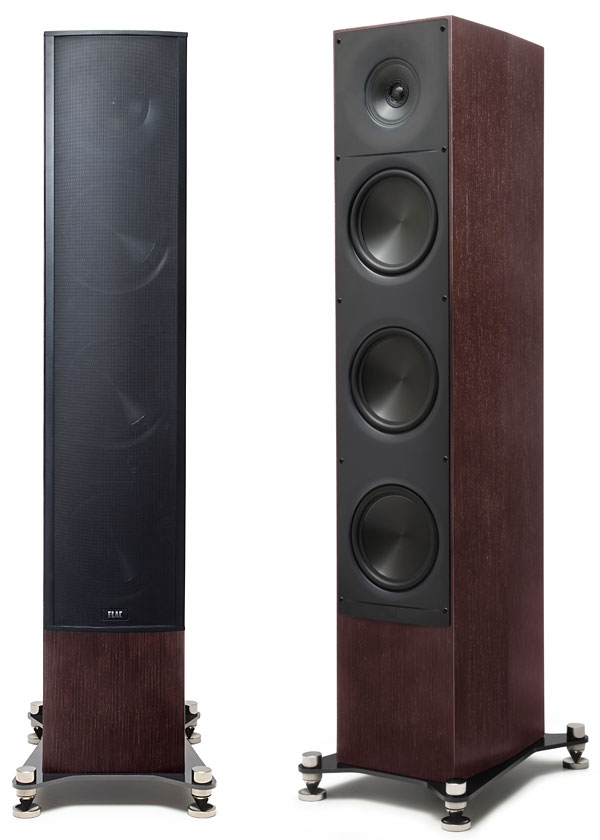 German manufacturer Elac had a significant North American presence in the 1960s and '70s, primarily with its Miracord automatic turntables. While it eventually disappeared from the US market, Elac never ceased to be a player in Europe, where it eventually shifted its primary focus from turntables to loudspeakers.
German manufacturer Elac had a significant North American presence in the 1960s and '70s, primarily with its Miracord automatic turntables. While it eventually disappeared from the US market, Elac never ceased to be a player in Europe, where it eventually shifted its primary focus from turntables to loudspeakers.When Elac decided to reenter the US market a few years ago, its success was hardly assured. Faced with hundreds of brand names and thousands of models fighting for attention, it hired veteran speaker guru Andrew Jones to improve the odds. In his previous work, first for KEF and then for TAD and Pioneer, Jones had built a solid reputation on designing well-received, cost-no-object speakers as well as high-value budget designs.
The results have been startling. Beginning with the aptly named Debut line, now in its second generation, and following up with the Uni-Fi series, Elac and Jones have made serious inroads in the sales of budget loudspeakers, reviving not only the Elac name but also an audio market too long smitten with blindingly priced speakers.
Nevertheless, Elac models have followed at higher, if not sky-high, prices. The company's current flagship line, Adante, comprises the AS-61 bookshelf model (and matching, optional, and recommended stands), the AC-61 center-channel, the SUB3070 subwoofer, and our subject here: the Adante AF-61 tower speaker ($5000/pair).
Design
Andrew Jones has used concentric drivers since his early years with KEF, and continues to favor them in all but his least expensive designs. For Elac they first appeared in the Uni-Fi range, and both the stand-mounted Adante AS-61 and the floorstanding AF-61 employ them as well.
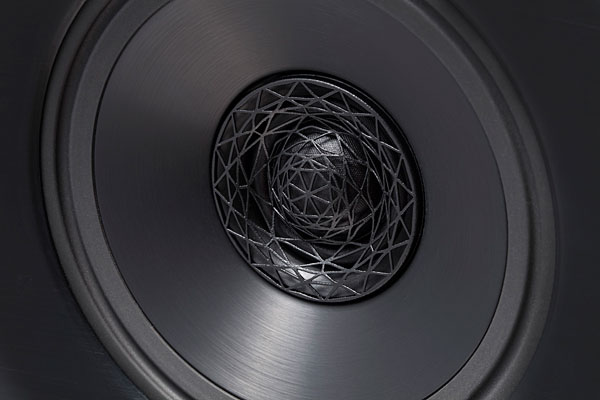
In a concentric driver, the tweeter is positioned at the apex of the midrange cone, the latter acting as a waveguide for the former. The main benefit of a waveguide is to reduce the tweeter's dispersion at the low end of its range: Since the midrange driver (or midrange-woofer) typically has restricted dispersion at the top of its range, where it hands off to the tweeter, reducing a tweeter's dispersion in that region can smooth the transition between the two drive-units' outputs. A waveguide can also, but not always, enhance a tweeter's dispersion at the top end of its range. The AF-61's concentric tweeter is protected by a web-like screen, and is crossed over to the aluminum-coned midrange at 2kHz.
That 5.25" midrange drive-unit has a 2" voice coil, which leaves plenty of room inside it for the wide-surround, 1" soft-dome tweeter. To isolate it from the woofers, this concentric driver is mounted at the front of its own separate, sealed chamber with anti-vibration mountings.
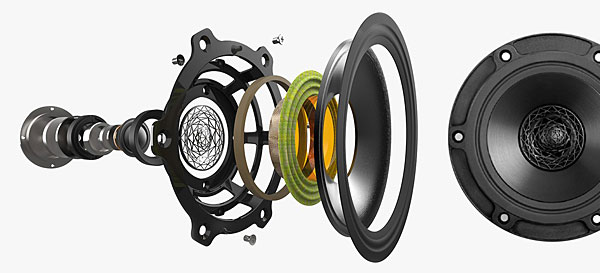
While it might appear from the outside that the three-way AF-61 has three 8" woofers, it doesn't. What you see are three passive radiators. Each of these is partnered to its own 6.5" woofer, which operates invisibly, in an internal subenclosure. Together with two ports, that driver radiates into a second, smaller subenclosure that contains the passive radiator. The woofer and its ports never face the outside of the cabinet. Instead, their energy simply activates the 8" passive radiator, the "driver" you see. In other words: Each of the three visible woofers in the AF-61 is one of three separately enclosed woofer "systems," each comprising a 6.5" driver with two internal ports energizing an 8" passive radiator, the latter's diaphragm simply passing all of the bass to the outside.
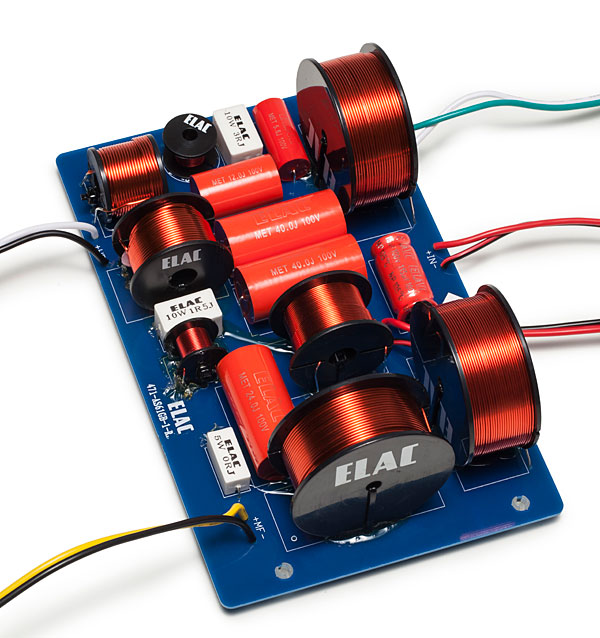
This arrangement acts as an acoustical filter, limiting the bass output to below 200Hz and eliminating some of the expensive crossover parts that would otherwise be needed to achieve the same low-pass crossover with a conventional network (a high-pass filter is still required on the midrange). It also eliminates audible port resonances. Elac calls this design Interport-Coupled Cavity loading.
This isn't a new idea, but rather a variation of what was called bandpass loading when it was first used, decades ago. It never caught on big, likely because it's somewhat complex and expensive. Regardless of possible savings on crossover parts, a passive radiator together with a more complex cabinet will still cost more than a cardboard or plastic port. But the Wayback Machine tickling the dark recesses of my brain says that KEF did use it in some of its designs, which may be where Elac's Andrew Jones first worked with or became aware of it.
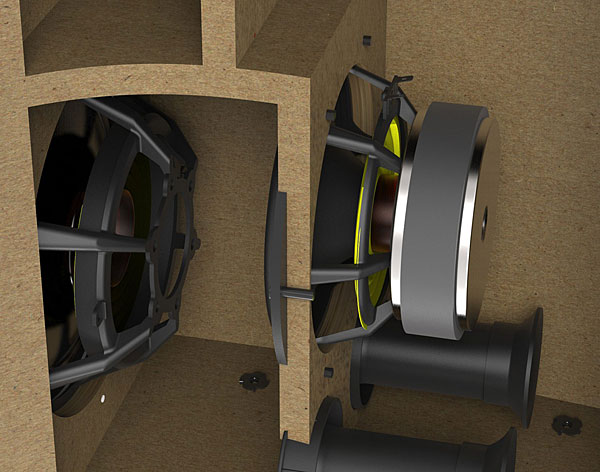
The cabinet structure required for this complex arrangement, with six separate internal chambers, not counting the small chamber for each midrange, makes for an extremely rigid enclosure, as rapping a knuckle on it painfully revealed. A heavy metal base plate, with outrigger corners and adjustable spikes, is also included. In addition, the AF-61s come with magnetically attached metal grilles. I used neither grilles nor spikes. The latter weren't sharp enough to penetrate the carpets that covered my hardwood floors, and if they had been I wouldn't put those floors at risk. I used a single run of speaker cable to each speaker, though biwiring or biamping are possible using each speaker's two pairs of high-quality binding posts. The available finishes are high-gloss black or white, or rosewood veneer (which looks more like dark walnut).
Setup
My listening area measures 21' long by 16' wide, with an oddly sloped ceiling at an estimated average height of 9'. This space is part of an open floor plan, with one of its 21' sides almost entirely open to a kitchen/breakfast area, which in turn opens into a dining room. The acoustic space is therefore far larger than the actual 21' by 16' listening area, which also accommodates the home-theater system used for my work for our sister publication Sound & Vision. That system includes two projection screens, but they're fully retracted when the main attraction is listening to music.
The room is relatively live, but apart from the kitchen, most of the floor area is covered with large, thick rugs. Shelves filled with books, CDs, and videos are on the back wall, several feet behind the listening seats.
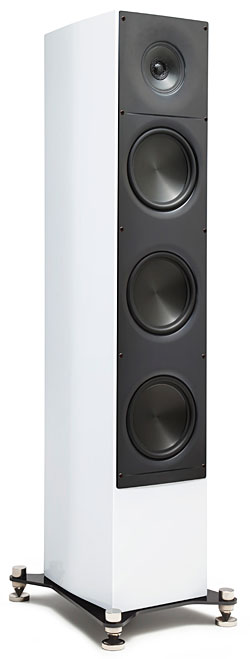 I drove the Elacs with two channels (except where noted) of a Marantz AV8802A surround-sound processor, connected to two channels of a Proceed AMP5 five-channel power amplifier. In stereo operation, each of the Proceed's channels is driven by a completely separate power supply and transformer, not just separate secondaries from the same transformer—as used here, it operates as two monoblocks built on one chassis. Proceed, now long gone from the market, was the home-theater branch of Mark Levinson, and 20 years ago, when new, the AMP5 sold for $5000 ($1000/channel), or about $7700/$1500 today, and was specified as producing 125Wpc into 8 ohms or 250Wpc into 4 ohms, all channels driven. Roughly the size of a high-end preamp, the AMP5 is small for a five-channel class-AB power amp but weighs over 100 lb. The source was a Marantz UD7007 universal BD player, connected to the Marantz pre-pro with a coaxial digital cable.
I drove the Elacs with two channels (except where noted) of a Marantz AV8802A surround-sound processor, connected to two channels of a Proceed AMP5 five-channel power amplifier. In stereo operation, each of the Proceed's channels is driven by a completely separate power supply and transformer, not just separate secondaries from the same transformer—as used here, it operates as two monoblocks built on one chassis. Proceed, now long gone from the market, was the home-theater branch of Mark Levinson, and 20 years ago, when new, the AMP5 sold for $5000 ($1000/channel), or about $7700/$1500 today, and was specified as producing 125Wpc into 8 ohms or 250Wpc into 4 ohms, all channels driven. Roughly the size of a high-end preamp, the AMP5 is small for a five-channel class-AB power amp but weighs over 100 lb. The source was a Marantz UD7007 universal BD player, connected to the Marantz pre-pro with a coaxial digital cable. Except as noted, all recordings used were on CD.
Listening
The 52"-tall Adante AF-61s are moderately imposing in a domestic setting. I set them up about 9' apart and 11' from the main listening position, which put their front baffles about 4' out from the front wall. The center of the AF-61's concentric tweeter-midrange is 46" above the floor, considerably higher than the typical seated ear height of 36–37". While my current listening ear height is a bit higher than that, it isn't close to 46". To compensate, I tilted the speakers forward slightly, and toed them in toward the listening seat. According to Andrew Jones, sitting slightly off the center axis on a concentric driver produces the lowest coloration, but I heard no clearly identifiable colorations in my setup.
 "In Your Wild Garden," from DALI Vol.2, originally released on Danish singer-songwriter Josefine Cronholm's Wild Garden (CD, Stunt 01232), features the singer backed by piano, double bass, and a lightly played drum kit. It sounded superb through the Elacs, with excellent overall balance, a clear, uncolored voice, and treble detail that was simply there, without exaggeration. Nothing was clearly missing. This track contains little deep bass, but what was there didn't sound thin. I might have preferred a bit more air at the very top end, but the highs weren't subdued in any obvious way.
"In Your Wild Garden," from DALI Vol.2, originally released on Danish singer-songwriter Josefine Cronholm's Wild Garden (CD, Stunt 01232), features the singer backed by piano, double bass, and a lightly played drum kit. It sounded superb through the Elacs, with excellent overall balance, a clear, uncolored voice, and treble detail that was simply there, without exaggeration. Nothing was clearly missing. This track contains little deep bass, but what was there didn't sound thin. I might have preferred a bit more air at the very top end, but the highs weren't subdued in any obvious way. The same DALI sampler also included the far more familiar "Train Song," by Tom Waits, here covered by Holly Cole, from her album Temptation (CD, Blue Note 31653), a recording every audiophile is required to hear before earning the Audiophile Merit Badge. Cole's voice was solidly between the speakers, if a little "big," as is common with closely miked pop recordings. The bass lines in the spare accompaniment were less prominent than I'm accustomed to hearing from this track, but were nevertheless well balanced, tight, and completely free of unnatural bloat.
A third track from DALI Vol.2, Elvis Presley's cover of "Fever," originally from Elvis Is Back! (CD, RCA Legacy 88697847402), is a superb 58-year-old recording. It sounded just a little rich and warm through the Adante AF-61s, but in a way that many listeners will find appealing, though this is typically a problem created by the room, not the speaker. Here it was definitely my room's fault: a bump in the response between 150 and 230Hz.
DALI Vol.3 sounded even more impressive through the Elacs, especially several superbly recorded men's and women's voices. It was on this disc that I first discovered the Danish singer Sinne Eeg, whose duo album with Thomas Fonnesbæk, Eeg Fonnesbæk, was one of my picks for the February 2018 edition of "Records to Die For." "My Treasure," from Eeg's Waiting for Dawn (CD, Sinne Music/Calibrated 002), was a rare treasure in itself, with clean but unobtrusive piano, double bass, and percussion accompanying Eeg's rich, expressive, open voice. None of this was shortchanged by the Elacs in any way.
The Adantes also performed beautifully on material with complex, high-frequency detail. Percussion-heavy recordings, ultimate bass extension excepted (more on this below), were reproduced with all their fast attacks and fine detail intact, but never with over-the-top brightness. Test Record 3: Dynamics (CD, Opus3 CD 8300) may be hard to find today, but it remains a superb collection of excerpts from the Opus3 catalog, much of it from the late 1970s and '80s. (Opus3 now offers many of its consistently great recordings on both SACD and a wide range of 15ips open-reel tapes, the latter at "if you have to ask" prices.)
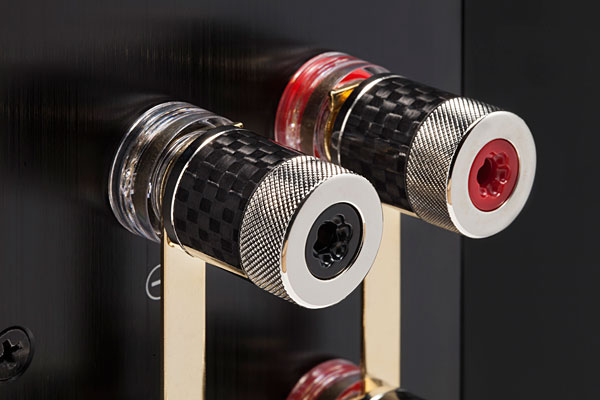
The selections on this sampler include panpipes and flutes (from Yuyachifca, Opus3 CD 7902); small groups as on Knud Jörgensen Jazz Trio (Opus3 CD 8401); a children's choir recorded for this sampler; an a cappella male voice (Eric Bibb singing "He's Got the Whole World in His Hand," also recorded for this release); two pipe-organ pieces performed by Torvald Torén: Vierne's Toccata, and a selection from D'Aquin's Noël, both heavy on the upper, trumpet-like pipes rather than the deep bass typical of most organ recordings; and much more.
All of these varied tracks were reproduced beautifully by the Adantes.

In the home theater
While using the Elacs as part of a home theater won't be of interest to all Stereophile readers, others will appreciate that they excelled with a wide range of film soundtracks, particularly those with good music scores (a prime consideration for me)—though they were also perfectly fine, with sub, at reproducing the firefights, car crashes, and explosions heard in the superhero saga of the month. There's also an Adante AC-61 center-channel speaker ($2000 each), but here I used a single AS-61 stand-mount ($1250 each / $2500 pair), turned on its side and placed on a low stand below the screen. The AS-61 uses the same concentric driver as in the AF-61 above 200Hz, and the match with the AF-61s was excellent.
Conclusions
With or without a subwoofer, I liked what I heard from the Adante AF-61s as soon as I hooked them up. I liked them even better after several weeks of listening. When I went back to check a few last-minute details while writing this review, I found it difficult to listen for only a few minutes and then return to my writing. I wanted to listen longer. I had to pull myself away. If that's not a solid recommendation, I don't know what is.
Questions for the seller |
|---|
| Is this price for a single or pair of bookshelf speakers? Hi,
This is for one pair, shipped insured to your door. :-). Thanks
-Brian,
Herndon Audio |
Ask the seller a public question
You must log in to ask a question.
Return Policy
Return Window
Item can be returned within 7 days of receipt.
General Terms
Items must be returned in their original condition, with all included packing materials and no signs of use. Buyer assumes responsibility for all shipping return costs unless the item was not received as described.
Refunds
Buyer will receive a full refund in the original payment method less any shipping charges.


